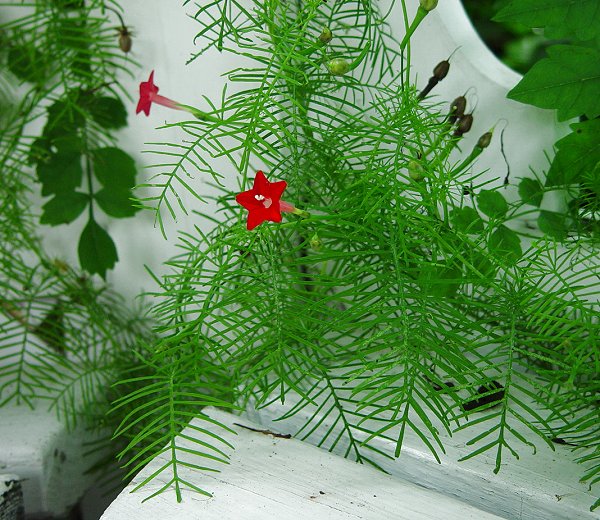Ipomoea quamoclit L.
Cypress Vine

Introduced
CC = *
CW = 5
MOC = 2
© DETenaglia
Ipomoea quamoclit L.Cypress Vine | |
 |
Introduced CC = * CW = 5 MOC = 2 |
© DETenaglia |
|
Family - Convolvulaceae Habit - Annual forb.
Stems - Scrambling or twining on other vegetation, to 5 m, glabrous. Leaves - Alternate, appearing compound, mostly short-petiolate. Blades 2-9 cm long, pinnately dissected into 9-19 pairs of lobes, appearing nearly pinnately compound, broadly ovate in outline, the lobes linear, sharply pointed at the tip, glabrous.
Inflorescences - Flowers solitary or in loose clusters of 2-5, glabrous. Flowers - Sepals similar in size and shape, or the outer 2 slightly shorter and narrower, 4-7 mm long, oblong-elliptic, rounded or narrowed to a bluntly pointed tip but with a minute, sharp point from just below the tip, glabrous. Corollas 2.2-3.5 cm long, trumpet-shaped, the tube slender, widened abruptly at the tip, red, with the throat usually yellow or white. Stamens exserted. Ovary 4-locular, the stigma 2-lobed.
Fruits - Ovoid capsules, the main body 7-10 mm long, the persistent style 5-9 mm long, glabrous. Seeds 4.5-5.5 mm long, the surface sparsely to moderately minutely hairy.
Flowering - June - October. Habitat - Streambanks, fencerows, roadsides, railroads, and open, disturbed areas. Origin - Native to tropical America. Lookalikes - Flowers similar to those of I. coccinea (but foliage is entirely different). Other info. - This strikingly attractive species is rare in Missouri, reported in a naturalized state from only two counties. Its U.S. distribution is likewise sparse and widely scattered, with most populations occurring in the far southern states. It is much more often cultivated, having both flowers and foliage which are very attractive. The brilliant red flowers are visited by hummingbirds. If allowed to mature fruit, these self-fertile plants will reseed themselves in future years. Photographs taken in Gainesville, FL., 6-22-02 and in Lochapoka, AL., 9-23-04 (DETenaglia); also at Missouri Botanical Garden, St. Louis County, MO, 8-26-2014 (SRTurner). |